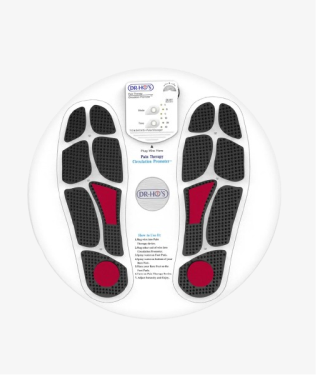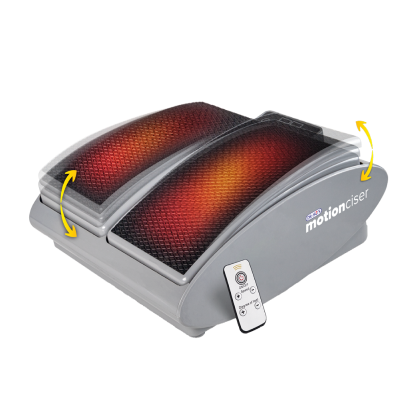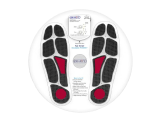Ankle Pain can stem from more than just physical activity
When we think of ankle pain, we often associate it with an injury sustained during physical activity. However, you don’t need to be an athlete or a weekend warrior to turn your ankle, twist it, bruise it or simply experience ankle pain. Walking on an uneven surface, stepping awkwardly, wear and tear, and even underlying health issues can all cause discomfort, debilitating ankle pain, or even foot and ankle pain. Foot pain is also a common issue that can arise from similar causes.
The pain you feel can also vary from burning to aching to throbbing, and it can arrive suddenly or even gradually, sometimes developing over a long period due to chronic issues or wear and tear. Keep on reading as we discuss the most common causes of ankle pain and highlight prevention and relief tips that may allow you to manage your pain more effectively.
Understanding the Anatomy of the Ankle
Your ankles are part of the musculoskeletal system. They work together to support your body’s weight and help you stand, balance and move. The flexible ankle joint allows you to point, flex, rotate and move your foot from side to side.
The lower leg bones come together to meet the foot bone to form the ankle, with the ligaments holding these bones together. A complex structure of tendons, muscles and other soft tissues allows mobility in the foot and ankle. The ankle is especially prone to injury because of this complexity. Because the foot ankle structure is so interconnected, comprehensive care is important to address both foot and ankle conditions effectively.
Factors that can put you at higher risk of experiencing Ankle Pain
Ankle pain and ankle injuries are very common. Factors that increase your risk of ankle pain include:
-
Age: As the body ages, wear and tear become more of a factor. This is especially true in key joints such as the ankle.
-
Sports and physical activities: Participating in sports or other physical activities that require jumping, cutting action, or rolling or twisting of the foot such as basketball, tennis, football, soccer and trail running can put you at risk of injuring or hurting your ankles.
-
Poor physical condition: A less active lifestyle can result in less flexibility and mobility in the legs, which in turn can potentially lead to a higher risk of injury.
-
Improper footwear: Often overlooked, wearing shoes that don’t fit properly or aren’t appropriate for an activity can potentially make the ankles more vulnerable to injury. Avoid flip flops, as they lack proper support and can increase the risk of ankle injuries or discomfort. Choose a shoe with a low heel and good support to help reduce pressure and provide better comfort.
-
Weight: Added body weight can put increased strain on high-use joints such as the ankle.
What are the causes of Ankle Pain?
If you’re experiencing ankle pain, it may be due to one of the following causes:
Arthritis
These two very common types of arthritis often lead to ankle pain:
-
Osteoarthritis: This type of arthritis happens when the cartilage in the ankle joints gradually deteriorates. Over time, this deterioration can cause the bones to rub against each other, forming bone spurs. The pain of osteoarthritis varies but often starts out as an achy, intermittent sensation that progresses with time into a sharper, more constant pain and can lead to loss of function.
-
Rheumatoid arthritis: This is an autoimmune condition in which a person's immune system attacks multiple joints throughout the body, and is quite common in the feet and ankles. Symptoms include pain, swelling, and stiffness in the joints.
Tendonitis
Refers to soft tissue injuries when tendons become irritated or inflamed. One of the most common types of tendonitis is Achilles tendonitis. The achilles tendon is the largest tendon in the body, joining your calf and lower leg muscles to your heel bone. Achilles tendonitis often causes a burning, tightening pain along the back of the ankle. Mild swelling may occur, along with morning stiffness in both the heel and the calf.
Any activity that places stress on the achilles tendon, such as playing sports that require sudden starting and stopping or a change in direction, or other physical activities, can trigger tendonitis.
Sprains
Another very common cause of ankle pain is sprained ankles. An ankle sprain happens when ligaments stretch or tear. Sprained or twisted ankles happen when the ankle rolls forcefully out of its normal position.
Fractures
Similar to ankle sprains, twisting or rolling the ankle, tripping on a curb, or falls may cause an ankle fracture. You will feel an immediate sharp pain accompanied by swelling, bruising, and an inability to put weight on the ankle.
How can I prevent Ankle Pain?
While it's difficult to entirely prevent accidental sprains, tears and breaks, it's still very important to keep your bones, joints, ligaments and tendons strong and healthy. How so? By ensuring you are taking care of your body! Here are some tips:
Watch your weight and boost your bone health with the right foods
A diet that is low in processed foods, low in trans fats and high in anti-inflammatory vitamins C and D can help support your bones and keep them strong. Another tip would be to swap out red, fatty meats for leaner options like turkey, chicken breast or salmon as your source of protein. Complement these options with healthy sides like broccoli or kale, which is an excellent source of fibre and calcium. Craving desserts? Look for cherries and berries as these make great additions to an anti-inflammatory diet. If you include exercises into your daily routine, make sure to refuel your body with a bowl of oatmeal with fruits and nuts and yogurt, rather than reaching for sweets.
If you experience persistent ankle pain, do not ignore it—see a doctor for advice. In many cases, you can self refer to medical services for ankle pain, making it easier and more convenient to access care. A healthcare professional can help diagnose the issue and treat your ankle pain effectively. They may recommend various treatments, including self-care options and professional interventions, to support your recovery.
Warm up properly before doing any exercises
Warming up properly before any physical activity is just as crucial as doing the activity itself. These ankle warm-up exercises can be done before any workout routine, from running to strength training, and will help relieve ankle pain and prevent injuries in the delicate parts of your ankles.
-
Resting is an important part of self-care for ankle pain, as taking breaks and reducing pressure on the inflamed area can alleviate discomfort.
-
Wearing supportive footwear is essential for treating ankle pain, as it helps prevent further injury and aids recovery during physical activity.
-
These steps can help reduce ankle pain, swelling, and inflammation, supporting your overall ankle health.
Achilles Tendon Stretching
The Achilles tendon is the strongest tendon in your body, connecting your calf muscles to your heel. It plays a vital role in walking, running, jumping, and even just standing on your toes. But when it becomes tight or overworked, it can lead to pain and stiffness. Here are some simple stretches that can help with this:
-
Wall Calf Stretch: Lean into a wall with one leg forward and the other straight back, heel down.
-
Bent-Knee Wall Stretch: Same position as above, but bend both knees slightly.
-
Heel Drop Stretch (on a Step): Stand on a step, drop your heels slowly below the step level.
-
Towel or Band Stretch: Sit with your leg extended, loop a towel or band around your foot, and gently pull your toes toward you.
Ankle Inversion
-
Sit with your legs straight out in front of you.
-
Turn your foot inward as far as possible.
-
Hold for 10 seconds.
-
Repeat five times.
Regular stretching and exercise not only help maintain mobility, but also improve blood flow to the ankle, which can aid in recovery and reduce pain.
As your foot turns inwards, you should notice it slightly bends up, exposing the bottom of your arch and foot. When this happens, you know you are performing the exercise properly.
Don't ignore your pain
If a movement or an activity feels uncomfortable, take a break. If the pain persists with more intensity, it's best to see your doctor for a diagnosis. Continuing exercises through pain can make injuries worse and exacerbate any underlying issues in your ankles.
RICE protocol
The RICE protocol is a standard home-based method of treating a variety of musculoskeletal injuries including ankle sprains and ankle tendonitis. The acronym stands for:
-
Rest: Simply rest the joint and allow the acute inflammation to subside. Most mild pain will dissipate within a few days.
-
Ice: Cold compression can help keep the swelling down and soothe your pain. Apply ice bags or cold gel packs to the affected area for 15 to 20 minutes, three or more times per day. Be sure not to apply the ice directly to your skin and wait 40 minutes to 45 minutes before applying ice again to allow tissues to return to normal temperature.
-
Compression: Compression bandages can help support and immobilize your ankle joint as it rests. That said, be sure to not compress too much. If you feel a sensation of numbness, tingling, increased pain or swelling in the foot or area of your ankle just below the bottom of the bandage or wrap, you might be applying an excessive amount of compression.
-
Elevation: Raising your ankle above the level of your heart (by propping your foot on pillows) can help reduce swelling for the first couple of days after an ankle injury.
Stretching & Exercise
When you're in pain, stretching or exercising may be the last thing you want to do. But refraining from movement may actually be making your pain worse by encouraging stiffness and preventing blood circulation. Staying mobile can help you improve your flexibility and range of motion while dealing with ankle pain. Plus, strengthening the lower limb muscles through exercise can help to reduce the stress on your joints over time. To ensure that you're engaging in movement safely, follow these tips:
-
Start with gentle movement: Ease yourself into exercise with a warmup. Try starting with a full-body stretch before going into strengthening or aerobic exercises.
-
Keep the impact low: Try low-impact exercises with the help of stationary equipment such as an elliptical or recumbent bicycle. Water aerobics can also help lessen physical stress on joints while you exercise.
-
Use ice post-workout: Apply ice to painful joints after exercise to prevent swelling and discomfort.
TENS & EMS Therapy for Ankle Pain
TENS Therapy (Transcutaneous Electrical Nerve Stimulation) and EMS (Electrical Nerve Stimulation) can be beneficial additions to your pain management routine:
TENS Therapy is delivered via a TENS device that conducts safe, gentle electrical stimulation through conductive, adhesive pads to pain-affected areas. Some TENS devices also use EMS Therapy so that both the nerves and muscle tissues are targeted with gentle stimulation. A TENS device can be an effective choice for temporarily relieving pain in the ankles; TENS can target pain from everyday activities such as household chores and work, and it can also provide symptomatic relief for chronic and arthritic pain. Here's what TENS and EMS do to help:
TENS Therapy: Through a TENS device, this pain therapy gently stimulates the nervous system to provide temporary relief of pain. Additionally, TENS therapy is thought to aid in the release of endorphins — a naturally occurring chemical that may also provide temporary pain relief.
EMS Therapy: EMS gently stimulates healthy muscles, causing them to contract and relax in order to increase local circulation and soothe sore and aching muscles. Stimulating healthy muscles can also help to improve and facilitate muscle performance. Turn it on and start to feel the soothing stimulations!
Find more information on TENS and product recommendations for pain relief:
-
Learn more about how a TENS machine works to temporarily relieve pain
-
Hip, Knee and Ankle Pain: Causes | Pain Relief Tips | Joint Care and Health
-
5 Lower Back Pain Relief Stretches & Simple Yoga Moves [Updated for 2021]
When to Seek Medical Attention
While many cases of ankle pain can be managed with self-care and at-home remedies, there are times when it’s crucial to seek help from a healthcare professional. Recognizing the signs of a more serious ankle injury or underlying health condition can make all the difference in achieving effective ankle pain treatment and preventing long-term complications.
People with flat feet or other structural foot issues are at higher risk for ankle pain and injuries. Wearing shoes with proper support and cushioning, as well as using soft insoles or orthotic inserts, can help reduce pain and prevent future problems. However, if you continue to experience discomfort or difficulty walking, a healthcare provider can offer additional solutions to ease pain and improve your quality of life.
Remember, severe or persistent ankle pain should never be ignored. By consulting a healthcare professional, you can receive an accurate diagnosis, effective ankle pain treatment, and guidance on how to reduce pain and prevent further injury. Prioritize your health and take action if you notice any concerning symptoms—your feet and ankles will thank you.
Take action today to start feeling better tomorrow!
As uncomfortable and painful as ankle pain can be, there are certainly things you can do to take action on your own terms! We hope the tips above will help you establish a pain management routine that works for you.
Disclaimer: This content is for informational purposes, and should not be treated as medical advice. While our advanced TENS machine can benefit various pain conditions through its sophisticated combination of TENS, EMS, and NMES guided by our proprietary AMP Technology, proper diagnosis ensures optimal pad placement and treatment protocols. Always consult a healthcare professional for an accurate diagnosis before beginning any treatment program.










